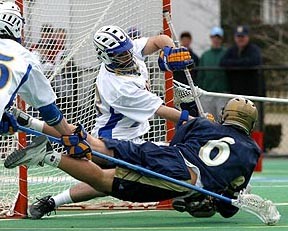 |
 |
||||||||||
Lacrosse FaceoffAre you interested in learning the basics of lacrosse faceoffs? or... Maybe you are already an experienced faceoff specialist, and just want to know how to improve your game more. Whatever your lacrosse faceoff desires, we have it here. Faceoffs are both physical and psychological. You are constantly trying to guess what the other player will be doing. The BasicsStick with me here... these things are all basic knowledge; so if you are experienced with faceoffs, then skip over this. There are three basic types of faceoff moves: Clamp, Jump, and Push (however, they are sometimes called different names). Rock, Paper, ScissorsIt sounds kind of stupid, but winning a lacrosse faceoff is a lot like the game: rock, paper, scissors. In order to beat an opponent who is clamping, you jump. To beat someone pushing, then you clamp. To beat someone jumping, you push. How do you know what your opponent is going to do? There are a few different ways that you can know what the opposing player is doing. Now, it is important to know that these signs are not always correct, but they are correct about 90% of the time. If the other person is going to clamp, then they will have their left wrist cocked back. If they are going to power clamp, then his two hands will be positioned the same way, with the top of the hands showing. In football terms, this could be seeing a lineman in four point stance. If they are going to jump, then both of their wrists will be straight. You may also see their right hand just hovering over the ground. They do this to get a better jump on the ball. When they are about to push the ball, then you will probably see their left hand cocked forward, with the front of their hand pointing at you. When they push, then you will counter with a clamp down the mid line, and to the right. The Face OffHow do you practice lacrosse faceoffs when you don't have anyone to practice with?It is very easy to do this. Start by taking your stance over the ball, and as quickly as you can, jump the ball over and over again. Do as many as you can in 30 seconds, then take a break. Do 3 to 5 sets of this for 30 seconds each. This will help your quickness of off the whistle.If you want to work on your clamp, or power clamp, then all you need is a wall. Take your stance with the wall about 3 feet away from you. Pretend that the ref is blowing the whistle each time to make it more real. Once the whistle blows, clamp down hard, and rake it out behind you. The wall is there to stop the ball from rolling very far. Illegal Faceoff MovesThere are a lot of illegal lacrosse faceoff moves that your opponent may do against you. Most of the time, the ref doesn't catch this. It is up to you to recognize when they are doing illegal moves, and tell the ref. The first, and usually the most common, is when they use their hand to interfere with the faceoff. They can either use their hand to pick up your stick, or use it to push the ball out. Using your hand to help with faceoffs is very common, and you have to be able to recognize it. It happens very fast. If you find that you are losing a lot of lacrosse faceoffs, take the time to watch what your opponent is doing, and see if he is using his hand illegally. Another illegal move that you should watch out for is when the opponent makes a noise before the whistle blows, which will cause you to false start. This move is harder to do because the refs can usually hear the person saying this. They may even call an unsportsmanlike penalty if they catch the person doing it. There are a lot of illegal faceoff moves that you need to watch out for. They are all totally illegal, and are used very often. Remember... A good faceoff player can win without cheating. Communicate with the other middiesCommunicate with your teammates on which way you are going to rake the ball to them.More often than not, the middie taking the faceoff cannot win the ball to himself. That is why you rake it out to your teammates who are running in. Be sure to communicate to them where they should be. If they don't get to the ball first, then it is often your own fault. I always place the long stick middie on my left side, because I usually win it to my right. I place the other middie back and to my left, to prevent the fast break. The lacrosse faceoff person is often overlooked on younger teams. College teams realize how much of an asset a good faceoff man is.
|
Find a topic...
|
Homepage | Contact Me | Sitemap | Privacy Policy
Buy Equipment | How to Play | History | Coaching | Drills | Plays | Equipment | Famous Players | Hits Positions | Recruiting | Tricks
Copyright©
2008-2016 Lacrosse-Information.com. No reproduction of material without express written permission of the webmaster. | Google
| |||||||||